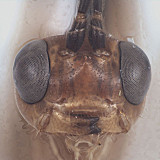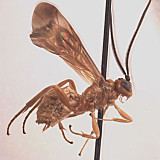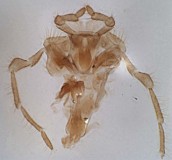Physotarsus adriani Gauld, 1997
Physotarsus adriani: Yu and Horstmann 1997: 455 (catalog); Zhaurova and Wharton 2009: 9-12 (redescription, inclusion in key to species).
Physotarsus adriani is readily recognized by the distinctive color pattern of the fore wing (very strongly yellowish proximally, blackish infumate distally), matched only in P. castilloi. The two are distinguished by color differences noted by Gauld (1997), and in the shape of the ventral margin of the clypeus which is not as strongly protruding in P. adriani. In P. adriani, the frons and first tarsomere of the hind leg are orange, whereas both are black in P. castilloi.
There are no specimens currently determined for this OTU, or those specimens determined for this OTU are not yet mappable.
This material is based upon work supported by the National Science Foundation under Grant Number DEB 0328922 with REU supplement DEB 0723663.
Any opinions, findings, and conclusions or recommendations expressed in this material are those of the author(s) and do not necessarily reflect the views of the National Science Foundation.




